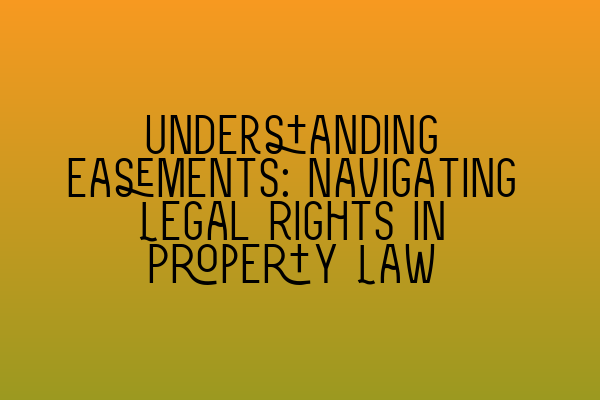Understanding Easements: Navigating Legal Rights in Property Law
Introduction
When it comes to property law, understanding easements is crucial for both property owners and prospective buyers. Whether you are purchasing a new property, subdividing land, or dealing with boundary disputes, having a clear understanding of easements can help you navigate the complex legal landscape and protect your rights.
In this blog post, we will delve into the intricacies of easements, exploring their definition, types, creation, and termination. We will provide you with the knowledge you need to confidently navigate the world of legal rights in property law. So, let’s dive in!
Defining Easements
In property law, an easement is a legal right that allows someone (known as the “beneficiary” or “dominant owner”) to use or access another person’s property (known as the “servient owner”) for a specific purpose. This right is attached to the land, rather than the individual, meaning it transfers with the property when it is sold or transferred.
Types of Easements
There are various types of easements, each serving a different purpose and carrying unique rights and responsibilities. Some common types of easements include:
1. Right of Way: This type of easement allows the beneficiary to pass through the servient owner’s land to access another location. It is commonly seen in situations where there is no direct road access to a property.
2. Easement by Necessity: When a property is landlocked and has no other reasonable means of access, an easement by necessity may be granted by the court to allow the beneficiary to access their property.
3. Easement by Prescription: If someone openly uses another person’s property for a specific period of time without the owner’s permission, they may acquire an easement by prescription. This is similar to adverse possession but grants only limited rights.
Creating an Easement
An easement can be created in several ways, including:
1. Express Grant: The servient owner voluntarily grants the easement to the beneficiary through a written agreement, such as a deed.
2. Express Reservation: When the servient owner sells a portion of their land, they may reserve an easement for their continued use or benefit.
3. Implication: If certain conditions are met, an easement may be implied by the court. This typically occurs when it is necessary for the reasonable use and enjoyment of the dominant owner’s land.
4. Prescription: As mentioned earlier, an easement by prescription can be created when someone openly uses another person’s property without permission for a specific period of time.
Terminating an Easement
Easements can be terminated in several ways, including:
1. Express Release: The beneficiary may voluntarily release their rights to the easement through a written agreement with the servient owner.
2. Merger: If the dominant and servient properties come under the same ownership, the easement may be automatically terminated.
3. Abandonment: If the beneficiary stops using the easement for an extended period of time and demonstrates their intention to abandon it, the easement may be terminated.
4. Expiry of Time: Some easements may have a specific timeframe attached to them, and they will terminate automatically once that timeframe expires.
Conclusion
Understanding easements is essential for anyone dealing with property law. Whether you are purchasing property, subdividing land, or dealing with boundary disputes, knowing your rights and obligations related to easements can protect your interests and prevent costly legal battles.
If you have further questions about easements or other aspects of property law, our team of experienced property solicitors at SQE Property Law & Land Law is here to assist you. Contact us today for personalized advice and expert guidance.
Related Articles:
– SQE 1 Practice Exam Questions
– SQE 1 Practice Mocks FLK1 FLK2
– SQE 2 Preparation Courses
– SQE 1 Preparation Courses
– SRA SQE Exam Dates
